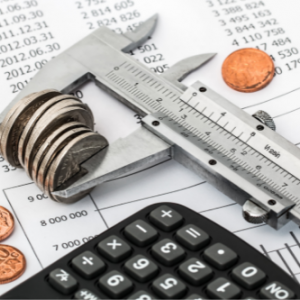The onset of the COVID-19 pandemic threw many business plans into disarray. With no forecasts, budget plans or revenue projections to account for the unfolding crisis, many executives were left scrambling to get to grips with not just the pandemic’s immediate impact, but its long-term consequences. This event alone makes a strong case for implementing financial modelling as an ongoing practice – no matter business scope or scale.
As the title of this article suggests, it’s long been assumed that financial modelling is only for big mergers and acquisitions. Large corporates draft in specialists to create scenarios, depending on the variables that impact the deal. However, there are many applications of financial modelling beyond this standard practice. In reality, financial modelling could be a valuable defensive tool in the face of any type of uncertainty.
This is, arguably, especially the case for smaller operations. According to a survey conducted by the NFIB in the United States, before the pandemic even struck, economic uncertainty was a major concern for small businesses and startups. This is why financial modelling isn’t just for the big players or high-stakes, one-off deals. In fact, it could be a key tool to shore up SMEs – which, after all, account for 90% of the global economy.
Table of Contents
Defining financial modelling
If you’ve worked with big corporates, you’ll undoubtedly be aware of the concept of financial modelling. However, for our purposes, it’s useful to define terms before continuing onto how these models can benefit SMEs. In short, financial modelling is a corporate planning tool that is used to forecast how a business will perform in the future, based on certain variables.
Assumptions are based on highly educated guesses rooted in historical data, trends, external factors, and industry and market statistics. By identifying these macro and microeconomic factors and correlating them with a company’s balance sheet, the person building the model can adjust assumptions and see the impact on the business plan and profit.
As such, a financial model isn’t only for investors or lenders – it can also improve decision-making and aid more agile business management. For SMEs and startups, it can help them answer some basic questions about the viability of their revenue model. A financial model also allows the business to track KPIs such as gross margin, operating income, earnings before income and taxes (EBIT), profit margin and net profit margin, depending on the specific type.
The case for financial modelling in SMEs and startups
No matter the state of the economy, businesses face challenges or opportunities that they can’t anticipate. Here’s a simple example: a supplier might be having problems. Or, severe weather might affect the supply chain. Equally, the variable could be positive; there might be a new business model that earns you unexpected gains. By developing a financial model that lets you analyse the impact of these events, you can be better prepared to handle the outcome.
We’ll reflect on the pandemic as an example once more. In April 2020, the OECD estimated that, across 32 countries, between 70 and 80% of SMEs experienced a drop in revenue of between 30 and 50%. Of course, this was absolutely unprecedented. By contrast, larger businesses were less hard hit. This, naturally, created a stark divergence between big players and the rest of the pack.
However, according to a report by McKinsey, there was a group of SMEs that displayed greater resilience. The actions these hardy SMEs took were more akin to that of larger companies – such as financial modelling. This gave them the financial resilience, operational capabilities and strategic advantage to adapt in the face of a worst-case scenario like the pandemic. Aided by full-throated investment in digitization, these companies were better able to weather the storm.
Look at it this way – these companies weren’t left counting life jackets when the ship was going down. They had a plan.
What an SME’s financial model should do
By developing a model that considers the impact of extraordinary events, it’s possible to work out how to address them. Although a financial model isn’t a crystal ball, at least outlining how you would react to some possibilities will give you a headstart. At the highest level, your financial model should help you plan for three main scenarios:
- If revenue remains stable.
- If demand increases significantly.
- If demand drops significantly.
The top-line implications for cash flow in each of those scenarios will have an effect on every area of the company, from finance to marketing. The model helps you determine the steps you would take to keep delivering to clients or customers while managing the spike or dip in demand.
Although building a financial model can be intimidating for small businesses (although don’t forget – consulting isn’t just for corporates) it’s absolutely necessary. Just look at the winners and the losers post-pandemic. In addition to preparing for future outcomes, financial modelling can be key to establishing financial discipline and tracking KPIs in a meaningful way.
More established SMEs can combine historical data with information from industry and market deports to develop scenarios. For startups, it’s a little more complex; without a sales history or customer satisfaction metrics, they’ll have to turn to industry and market research. However, this is arguably crucial – if startups are looking for investors, financial modelling could be central to their negotiation strategy.
Types of financial modelling
If you are in any way familiar with financial modelling, you’ll likely be aware of the three-statement model; it’s the godfather of financial modelling if you will. These analyses link three core financial statements (the income statement, balance sheet, and cash flow) with assumptions and formulas.
With these, you can create a forecast for a given period. Along with capital expenses, depreciation costs, and historical data, a finance professional can use those numbers to develop key assumptions and apply formulas to see the projections. However, this is just the beginning: once the three-statement financial model is in place, other models can be applied to forecast the effects of various assumptions.
Sensitivity or “what-if” analysis
A sensitivity analysis measures the effects of changes such as selling price, supply chain costs, sales, deliveries, or any other numbers. Generally, this model will tweak one variable at a time and demonstrate the impact of that change. That’s why they’re also known as a “what-if” analysis; they measure the outcome to the question “what if…x happens”, and so forth.
This model challenges decision-makers to analyse the reliability of the assumptions made in their top-line three-statement model. It’ll highlight ‘sensitivities’ in the business model and consider which factors will have the biggest impact on the expected forecast.
Scenario analysis
This model is closely related to sensitivity analysis but involves changing all or several variables at once. A scenario analysis looks at historical data and uses this information to make predictions, including major events that would have a lasting impact on the company – take, for example, the effects of a global pandemic. It typically includes a base-case, worst-case and best-case scenario. On a less macroeconomic scale, it could also be used to model the effect of losing a key customer.
Strategic forecast model
Businesses use a strategic forecast model to see how various projects would impact long-term, strategic goals. Otherwise known as long-range forecasting, a company may use these models to project the funding constraints and potential revenue of launching a new product line, taking the company globally, or opening a second manufacturing plant. It can then determine whether it’s in the business’s best interest to go ahead with these initiatives.
Discounted cash flow analysis
One euro, pound, dollar, or whatever currency your company trades in, is always worth more now than it will be in two years. That is, in essence, the nature of inflation – and this is where financial modelling becomes less intuitive. If the business’s revenue is stable each month, cash flow is predictable. However, if you make an investment now that will open new revenue streams, the money you earn in the future is not worth as much in real terms as the money spent right now.
Instead of investing that money in the business – by opening new premises, purchasing equipment or buying more inventory, for example – it could be invested or banked. So to know the value of investment now, you need to discount the money you expect to earn in the future. This is the foundation of a discounted cash flow analysis.
The sting in the tail is deciding what that discount rate should be. Here’s a scenario: an established small business has a customer who is ready to sign a five-year contract. This contract is the basis for the new investment. As long as that customer has a strong business, you have a relatively safe bet – you can be fairly confident the company will receive a set income for five years.
You also need to look at the historical data. If the estimated return on investments has historically been 10% short of expectations, the discount rate needs to reflect that. That is, the discount rate also incorporates a measure of risk based on market trends, company history or both. This discount rate is used to calculate the net present value of your investment, and if it’s positive, it’s a good investment.
Equally, if you borrow money to run the business discount cash analysis can quantify the ‘value’ of that borrowing. This formula is the WACC or the weighted average cost of capital employed in the venture or project. For example, say a project uses 70/30 debt to equity split for funding or capital to run the business. There is a cost for each funding source; that is, debt will be charged at the rate set by the lender. Sometimes this will be a fixed rate, or in others a floating rate.
The equity cost is the return required from equity or shareholders. This will normally be a risk-free rate in the market plus a risk premium. The risk premium will take into account the risks according to the company, industry, or region. The formula is then:
WACC = interest rate on debt * (1- tax rate) * % funding from debt + Required return from equity providers * % funding from equity.
It’s important to note that there is a tax element for interest on debt, as the accounting entry for interest on debt is made before the calculation of tax on the income statement. This means the interest is a deductible expense for tax purposes, so the net interest rate after-tax benefit is taken into account.
The complexity surrounding making these types of predictions was a key reason that capital investment dried up in many industries during the pandemic. The risk factor associated with future business and economies made it very difficult to estimate a proper discount rate because investors weren’t sure how things were going to unfold. As a result, this made many investors very risk-averse.
Use cases for financial modelling outside MA
Before wrapping up, here are a couple of examples where financial modelling has tangible, material value for SMEs, or indeed, companies on any scale that want to apply the principles to other use cases.
For example, in one scenario, a large wind turbine project needed to identify the best supplier: Nordix, Siemens, Goldwind, or Vestas. Apart from the different capital and operational costs associated with each supplier, they also offer various sizes. With every variable in place, the project could use a scenario analysis or discount cash flow analysis to determine which is the best investment.
Then, from the macro to the micro, take a small bicycle repair shop. The business needs to decide which stock to hold on the shop floor. Is more expensive, a slow-moving stock with larger margins a better bet, or less expensive, fast-paced consumables with lower margins? With a “what-if” financial model, the owner can determine the best value of a stock given working capital and other financial constraints.
There’s no reason why small businesses can’t think big
Despite unprecedented challenges, there are many SMEs all over the world that have demonstrated remarkable resilience in the face of the pandemic. More often than not, it’s those that are willing to think big that get ahead. By deploying methodologies traditionally reserved for big corporates, these businesses are thriving and surviving.
A key strategy is financial modelling. By being prepared for whatever the economic environment throws at you – whether it be a hiccup in the supply chain, or indeed, a global health crisis – you’re naturally in a far stronger position than you would be otherwise. The prospect of crunching the numbers may seem daunting, but it’s undoubtedly worth it.
Ultimately, the same goes for businesses of any scale. If a large corporation is embarking on a new project or investment, applying financial modelling guarantees an intelligent, switched-on approach. If the past year has told us anything, it’s to expect the unexpected – including a nigh-on global economic shutdown.
This is where collaboration is key; if it’s because you’re a small business or startup with little experience or a department in a corporation that doesn’t usually engage with financial modellers, don’t be shy to draft them in. They could give the business plan a whole new dimension of depth and clarity.
Finding financial modellers with Outvise
Outvise’s portfolio of experts includes financial modellers and strategists that have experience working with major investors and consulting firms. No matter the scope of the business – whether it’s traditional M&A or startups looking to future-proof their operation – Outvise provides the relevant freelance expertise. Click here to explore the platform.
Gerrit Eloff has been working in a multicultural and multinational environment for the majority of his career. A qualified actuary through the institute of actuaries in London with extensive experience working with Executive committee members, board members and shareholders, assisting them in defining strategy based on detailed data analysis and predictive financial models.
He has 20 years of broad financial modelling experience spanning across the full business planning cycle, from initial financial assessment, pricing strategies, business sensitivity analysis, valuations, funding structures to investor negotiation modelling.




No comments yet
There are no comments on this post yet.